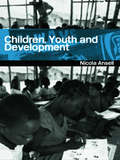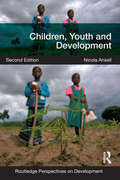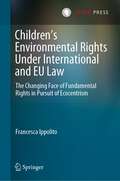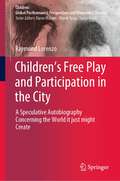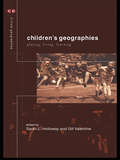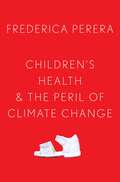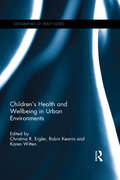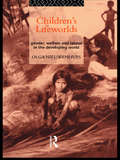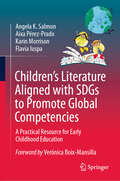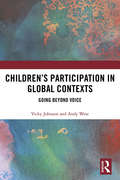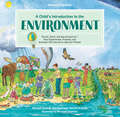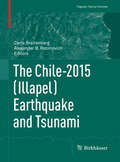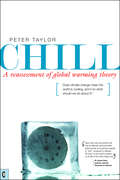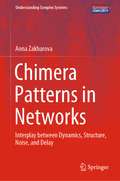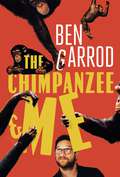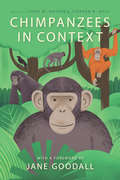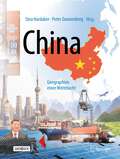- Table View
- List View
Children, Youth and Development
by Nicola AnsellChildren constitute a large part of the population of developing countries. Throughout the developing world, experiences of childhood are extremely diverse, both between places and between children in particular places, from the international level through to the different treatment of a boy and a girl within the same household. This informative book considers issues such as education, child labour, street children, child soldiers, refugees, child slaves, the impact of environmental change and hazards on children and the way that children, with the enthusiasm and energy to bring about change, can be enabled to participate in 'development'.
Children, Youth and Development
by Nicola AnsellChildren constitute a large part of the population of developing countries. Throughout the developing world, experiences of childhood are extremely diverse, both between places and between children in particular places, from the international level through to the different treatment of a boy and a girl within the same household. This informative book considers issues such as education, child labour, street children, child soldiers, refugees, child slaves, the impact of environmental change and hazards on children and the way that children, with the enthusiasm and energy to bring about change, can be enabled to participate in 'development'.
Children, Youth and Development (Routledge Perspectives on Development)
by Nicola AnsellThe new updated edition of Children, Youth and Development explores the varied ways in which global processes in the form of development policies, economic and cultural globalisation, and international agreements interact with more locally specific practices to shape the lives of young people living in the poorer regions of the world. It examines these processes, and the effects they have on young people’s lives, in relation to developing theoretical approaches to the study of children and youth.? This landmark title brings together the stock of knowledge and approaches to understanding young people’s lives in the context of development and globalization in the majority world for the first time. It introduces different theoretical approaches to the study of young people, and explores the ways in which these, along with predominantly Western conceptions of childhood and youth, have influenced how majority world children have been viewed and treated by international agencies. Contexts of globalisation and growing international inequality are explored, alongside more immediate contexts such as family and peer relationships. Chapters are devoted to groups of children deemed to be in need of protection and to debates concerning children’s rights and their participation in development projects. Young people’s health and education are considered, as is their involvement in work of various kinds, and the impacts of environmental change and hazards (including climate change). The book introduces material and concepts to readers in a very accessible way and within each chapter employs features such as boxed case studies, summaries of key ideas, discussion questions and guides to further resources. This edition has been updated to take account of significant changes in the contexts in which poor children grow up, notably the financial crisis and changing development policy environment, as well as recent theoretical developments. It is aimed at students on higher level undergraduate and postgraduate courses, as well as researchers who are unfamiliar with this area of research and practitioners in organisations working to ameliorate the lives of children in majority world countries.
Children, Youth and Development (Routledge Perspectives on Development)
by Nicola AnsellThe new updated edition of Children, Youth and Development explores the varied ways in which global processes in the form of development policies, economic and cultural globalisation, and international agreements interact with more locally specific practices to shape the lives of young people living in the poorer regions of the world. It examines these processes, and the effects they have on young people’s lives, in relation to developing theoretical approaches to the study of children and youth.? This landmark title brings together the stock of knowledge and approaches to understanding young people’s lives in the context of development and globalization in the majority world for the first time. It introduces different theoretical approaches to the study of young people, and explores the ways in which these, along with predominantly Western conceptions of childhood and youth, have influenced how majority world children have been viewed and treated by international agencies. Contexts of globalisation and growing international inequality are explored, alongside more immediate contexts such as family and peer relationships. Chapters are devoted to groups of children deemed to be in need of protection and to debates concerning children’s rights and their participation in development projects. Young people’s health and education are considered, as is their involvement in work of various kinds, and the impacts of environmental change and hazards (including climate change). The book introduces material and concepts to readers in a very accessible way and within each chapter employs features such as boxed case studies, summaries of key ideas, discussion questions and guides to further resources. This edition has been updated to take account of significant changes in the contexts in which poor children grow up, notably the financial crisis and changing development policy environment, as well as recent theoretical developments. It is aimed at students on higher level undergraduate and postgraduate courses, as well as researchers who are unfamiliar with this area of research and practitioners in organisations working to ameliorate the lives of children in majority world countries.
Children’s Environmental Rights Under International and EU Law: The Changing Face of Fundamental Rights in Pursuit of Ecocentrism
by Francesca IppolitoThis book is dedicated to a topic which has for a long time lacked the attention it deserves within the academic world. It intends to address in a coherent and comprehensive manner the problem of the environmental rights of the child, which are not identical to the ones of adults whose environmental rights have been appraised from a general point of view. In the absence of any international law instrument explicitly granting a child the right to a clean environment, drawing on an extensive and original analysis of the UN Convention on the Rights of the Child and the practice of its monitoring body, this book undertakes an assessment of the extent to which these challenges may be overcome through a greater engagement between international law on the rights of the child and international environmental law. The result is the first comprehensive study on the manner in which these two mutually reinforcing legal regimes can interact to strengthen the protection of children’s environmental human rights at stake in the increased strategic environmental and climate litigations at both the national and international level. The book is recommended reading for, amongst others, policy makers, international environmental lawyers and human rights lawyers and practitioners. Additionally, lecturers, students and researchers from a range of disciplines will also gain from seeing how new legal scholarship and intertwined branches of international law contribute to the continual development of the living rights of the human rights conventions. Francesca Ippolito is Associate Professor of International Law in the Department of Political and Social Science of the University of Cagliari, Italy. She holds the Jean Monnet Chair on European Climate of Change - REACT for 2021-2024.
Children’s Free Play and Participation in the City: A Speculative Autobiography Concerning the World it just might Create (Children: Global Posthumanist Perspectives and Materialist Theories)
by Raymond LorenzoThis book presents an interplay of imaginative memoir-telling, action research data and future projection that reminds and inspires experiences academics, researchers, professionals, as well as a wider public to recognize the fundamental importance and the impellent need for more and better work in favour of true political and societal recognition of the needs and rights of children to play freely, to participate, to live fully and enjoy their neighbourhoods and cities, and to imagine and construct alternative futures, together with adults. The book's abundant spoken dialogue is, in effect, storytelling between children (and youth) on their own and with adults (especially the elderly). It conveys an appreciation of children’s special capacities to think critically about their everyday places—and the greater world around them—and to develop solutions (or ‘projects’) for the problems they identify. This book serves an effective catalyst for stimulating rich discussion of the theoretical and practical bases of the many themes, or areas of study, which are treated in the story.
Children's Geographies: Playing, Living, Learning (Critical Geographies)
by Gill Valentine Sarah L. HollowayChildren's Geographies is an overview of a rapidly expanding area of cutting edge research. Drawing on original research and extensive case studies in Europe, North and South America, Africa and Asia, the book analyses children's experiences of playing, living and learning.The diverse case studies range from an historical analysis of gender relationss in nineteenth century North American playgrounds through to children's experiences of after school care in contemporary Britain, to street cultures amongst homeless children in Indonesia at the end of the twentieth century. Threaded through this empirical diversity, is a common engagement with current debates about the nature of childhood.The individual chapters draw on contemporary sociological understandings of children's competence as social actors. In so doing they not only illustrate the importance of such an approach to our understandings of children's geographies, they also contribute to current debates about spatiality in the social studies of childhood.
Children's Geographies: Playing, Living, Learning (Critical Geographies)
by Gill Valentine Sarah L. HollowayChildren's Geographies is an overview of a rapidly expanding area of cutting edge research. Drawing on original research and extensive case studies in Europe, North and South America, Africa and Asia, the book analyses children's experiences of playing, living and learning.The diverse case studies range from an historical analysis of gender relationss in nineteenth century North American playgrounds through to children's experiences of after school care in contemporary Britain, to street cultures amongst homeless children in Indonesia at the end of the twentieth century. Threaded through this empirical diversity, is a common engagement with current debates about the nature of childhood.The individual chapters draw on contemporary sociological understandings of children's competence as social actors. In so doing they not only illustrate the importance of such an approach to our understandings of children's geographies, they also contribute to current debates about spatiality in the social studies of childhood.
Children's Health and the Peril of Climate Change
by Frederica PereraToday, approximately two billion children breathe toxic air at levels exceeding standards set by the World Health Organization, causing immediate and long-term physical and mental health effects. Nearly every child around the world is at risk from at least one climate-related shock such as severe heat, flooding, drought, air pollution, forest fires, water scarcity, and displacement. Air pollution and climate change, largely driven by emissions from fossil fuel, are widening inequality in children's health. From urban centers in the United States to remote villages in the furthest corners of Asia, we are seeing the effects of our inaction on climate change affecting the next generation--even those still in utero. The global transition away from fossil fuel to a low carbon economy creates a major opportunity for the health and future of our children, but only if we all take action. Children's Health and the Peril of Climate Change brings to light the mental and physical harms to children's health inflicted by climate change and its root cause--our addiction to fossil fuel. Drawing on the author's extensive expertise in children's environmental health, this essential and thought-provoking text exposes the unique vulnerability of the developing child and the multiple and synergistic effects of climate change and air pollution on child health, especially for disadvantaged children. However, it also shows how all children, regardless of their generational wealth or birth country, are imperiled by climate change. While this book provides specific evidence for the escalating dangers of climate change, it also presents a roadmap to a brighter future with case studies of climate change and air pollution policies that have benefitted children's health and the economy. Through facts and compelling storytelling, Frederica Perera shares the growing power of advocacy by youth, environmental justice, and Indigenous groups. She describes the many solutions now available, highlighting the need for integrated climate and social policies to accelerate the transition into a zero-carbon future. Leveraging the universally shared value of protecting children, Children's Health and the Peril of Climate Change is a call to action to replace denial and despair around climate change with purpose and commitment for a healthier, more sustainable future.
Children's Health and the Peril of Climate Change
by Frederica PereraToday, approximately two billion children breathe toxic air at levels exceeding standards set by the World Health Organization, causing immediate and long-term physical and mental health effects. Nearly every child around the world is at risk from at least one climate-related shock such as severe heat, flooding, drought, air pollution, forest fires, water scarcity, and displacement. Air pollution and climate change, largely driven by emissions from fossil fuel, are widening inequality in children's health. From urban centers in the United States to remote villages in the furthest corners of Asia, we are seeing the effects of our inaction on climate change affecting the next generation--even those still in utero. The global transition away from fossil fuel to a low carbon economy creates a major opportunity for the health and future of our children, but only if we all take action. Children's Health and the Peril of Climate Change brings to light the mental and physical harms to children's health inflicted by climate change and its root cause--our addiction to fossil fuel. Drawing on the author's extensive expertise in children's environmental health, this essential and thought-provoking text exposes the unique vulnerability of the developing child and the multiple and synergistic effects of climate change and air pollution on child health, especially for disadvantaged children. However, it also shows how all children, regardless of their generational wealth or birth country, are imperiled by climate change. While this book provides specific evidence for the escalating dangers of climate change, it also presents a roadmap to a brighter future with case studies of climate change and air pollution policies that have benefitted children's health and the economy. Through facts and compelling storytelling, Frederica Perera shares the growing power of advocacy by youth, environmental justice, and Indigenous groups. She describes the many solutions now available, highlighting the need for integrated climate and social policies to accelerate the transition into a zero-carbon future. Leveraging the universally shared value of protecting children, Children's Health and the Peril of Climate Change is a call to action to replace denial and despair around climate change with purpose and commitment for a healthier, more sustainable future.
Children's Health and Wellbeing in Urban Environments (Geographies of Health Series)
by Christina R. Ergler, Robin Kearns and Karen WittenHow children experience, negotiate and connect with or resist their surroundings impacts on their health and wellbeing. In cities, various aspects of the physical and social environment can affect children’s wellbeing. This edited collection brings together different accounts and experiences of children’s health and wellbeing in urban environments from majority and minority world perspectives. Privileging children’s expertise, this timely volume explicitly explores the relationships between health, wellbeing and place. To demonstrate the importance of a place-based understanding of urban children’s health and wellbeing, the authors unpack the meanings of the physical, social and symbolic environments that constrain or enable children’s flourishing in urban environments. Drawing on the expertise of geographers, educationists, anthropologists, psychologists, planners and public health researchers, as well as nurses and social workers, this book, above all, sees children as the experts on their experiences of the issues that affect their wellbeing. Children’s Health and Wellbeing in Urban Environments will be fascinating reading for anyone with an interest in cultural geography, urban geography, environmental geography, children’s health, youth studies or urban planning.
Children's Health and Wellbeing in Urban Environments (Geographies of Health Series)
by Christina R. Ergler Robin Kearns Karen WittenHow children experience, negotiate and connect with or resist their surroundings impacts on their health and wellbeing. In cities, various aspects of the physical and social environment can affect children’s wellbeing. This edited collection brings together different accounts and experiences of children’s health and wellbeing in urban environments from majority and minority world perspectives. Privileging children’s expertise, this timely volume explicitly explores the relationships between health, wellbeing and place. To demonstrate the importance of a place-based understanding of urban children’s health and wellbeing, the authors unpack the meanings of the physical, social and symbolic environments that constrain or enable children’s flourishing in urban environments. Drawing on the expertise of geographers, educationists, anthropologists, psychologists, planners and public health researchers, as well as nurses and social workers, this book, above all, sees children as the experts on their experiences of the issues that affect their wellbeing. Children’s Health and Wellbeing in Urban Environments will be fascinating reading for anyone with an interest in cultural geography, urban geography, environmental geography, children’s health, youth studies or urban planning.
Children's Lifeworlds: Gender, Welfare and Labour in the Developing World
by Olga NieuwenhuysChildren's Lifeworlds examines how working children face the challenge of having to combine work with school in Kerala. Moving beyond the usual concern with child labour and welfare to a critical assessment of the daily work routine of children, this book questions how class and kinship, gender and household organization, state ideology and education influence and conceal the lives of children in developing countries. Presenting an extraordinarily sympathetic and detailed case study of boys' and girls' work routine in a south Indian village, this book shows children creating the visibility of their work. The combination of personal experience, quantitative data and in-depth anthropological methods, sheds light on the world of those who, though they hold the future, have been left in the dark.
Children's Lifeworlds: Gender, Welfare and Labour in the Developing World
by Olga NieuwenhuysChildren's Lifeworlds examines how working children face the challenge of having to combine work with school in Kerala. Moving beyond the usual concern with child labour and welfare to a critical assessment of the daily work routine of children, this book questions how class and kinship, gender and household organization, state ideology and education influence and conceal the lives of children in developing countries. Presenting an extraordinarily sympathetic and detailed case study of boys' and girls' work routine in a south Indian village, this book shows children creating the visibility of their work. The combination of personal experience, quantitative data and in-depth anthropological methods, sheds light on the world of those who, though they hold the future, have been left in the dark.
Children’s Literature Aligned with SDGs to Promote Global Competencies: A Practical Resource for Early Childhood Education
by Angela K. Salmon Aixa Pérez-Prado Karin Morrison Flavia IuspaThis book presents children’s literature as a platform for learning and helping young readers develop the knowledge, skills, and attitudes needed to thrive in an interconnected and diverse global society. It draws from various theoretical frameworks and research findings to implement critical literacy and culturally responsive teaching in the meaning-making process.The book focuses on global competencies and Sustainable Development Goals (SDGs) as intertwined concepts that work together to foster a more sustainable, inclusive, and equitable world. Developing global competencies empowers children and communities to actively participate in achieving the SDGs and addressing the pressing challenges of our time. The authors set high expectations on children as actors in transforming society. To facilitate this, the book offers an overview of child development theories as a foundation for designing developmentally appropriate practices to extend children’s books toward deep thinking and understanding. The book includes sample lessons that use cutting-edge research-based pedagogies and tools such as visible thinking routines and other approaches. Those lessons also help readers identify the Habits of Mind (HOM) children can develop by listening to and discussing stories. The HOM are attributes of good problem-finders and problem-solvers needed when confronting complex issues. The book provides resources and sample lessons that implement different thinking strategies to engage children in questioning and analyzing what they read, making them more critical. This is how children deeply understand the world and their role in creating positive change. The book aims to cultivate change-makers and global citizens through stories. It offers innovative approaches, including online learning options in accessible and engaging ways to help children think globally and act locally‘Through the power of children’s literature, this book serves a larger agenda: To build a more thoughtful world for future generations. By caring for and learning from one another through suggested activities in this book, they will share the riches and resources from across the world. As children learn about the promise of actions toward the UN Sustainable Goals, they can imagine living in an interdependent learning community where all people continually searching for ways to trust each other, learn together, and grow toward greater intelligence.’ Arthur Costa and Bena Kallick, Co-Founders and Directors of The Institute for Habits of Mind
Children’s Participation in Global Contexts: Going Beyond Voice
by Vicky Johnson Andy WestChildren's and young people’s right to participate has been increasingly acknowledged and taken up internationally, as expressed in the UN Convention on the Rights of the Child. Yet much of this has focused on collecting children’s voices, rather than achieving change, and has met its limits. This book provides an analysis of children’s participation in formal, collective and action research processes in six different international settings. It offers a deeper understanding of what helps and facilitates children's and young people’s participation through research, evaluation and decision-making to go beyond voice and effect change. This analysis is set in the context of historical and current discourses of participation, the sociology of childhood, contemporary anthropology, children’s geography and international development. Themes addressed include time and processes in children’s participation, shifting and multiple identities of children, political and cultural contexts, places and spaces children inhabit, skills and capacities of adults, accountability and power. The analysis promotes an approach to children’s participation as relational and collaborative, and will contribute to answering some of the questions facing practitioners and researchers embarking on participatory enquiry with children and young people. This is an invaluable book for practitioners and for scholars, postgraduates in anthropology, sociology, human geography, childhood studies, development studies, social policy, social work, community work, education, youth work and those with an interest in citizenship, children’s rights and human rights. Researchers and practitioners in UN, government and non-government services will also find it applicable to engaging with children and young people.
Children’s Participation in Global Contexts: Going Beyond Voice
by Vicky Johnson Andy WestChildren's and young people’s right to participate has been increasingly acknowledged and taken up internationally, as expressed in the UN Convention on the Rights of the Child. Yet much of this has focused on collecting children’s voices, rather than achieving change, and has met its limits. This book provides an analysis of children’s participation in formal, collective and action research processes in six different international settings. It offers a deeper understanding of what helps and facilitates children's and young people’s participation through research, evaluation and decision-making to go beyond voice and effect change. This analysis is set in the context of historical and current discourses of participation, the sociology of childhood, contemporary anthropology, children’s geography and international development. Themes addressed include time and processes in children’s participation, shifting and multiple identities of children, political and cultural contexts, places and spaces children inhabit, skills and capacities of adults, accountability and power. The analysis promotes an approach to children’s participation as relational and collaborative, and will contribute to answering some of the questions facing practitioners and researchers embarking on participatory enquiry with children and young people. This is an invaluable book for practitioners and for scholars, postgraduates in anthropology, sociology, human geography, childhood studies, development studies, social policy, social work, community work, education, youth work and those with an interest in citizenship, children’s rights and human rights. Researchers and practitioners in UN, government and non-government services will also find it applicable to engaging with children and young people.
A Child’s Introduction to the Environment: The Air, Earth, And Sea Around Us -- Plus Experiments, Projects, And Activities You Can Do To Help Our Planet! (A\child's Introduction Ser.)
by Michael Driscoll Dennis Driscoll Meredith HamiltonExplore the water, land, and air around us with this entertaining and informative look at our magnificent planet—and learn how your experiments, activities, and everyday actions can help save the environment. This book looks at the wide variety of ecosystems and environmental regions of the Earth, from deserts and forests, to cities and farms, to oceans and ice caps, as well as the atmosphere, weather, energy sources, plants, and animals of each area. Michael Driscoll and professor of meteorology Dennis Driscoll explain the changes to our planet that are currently taking place, including rising temperatures and sea levels, and the effects they can have on our environment. They also profile young environmental activists like Greta Thunberg and Isra Hirsi, and highlight important, everyday actions such as water conversion and recycling that kids can do on their own or with their parents. Also included are fun projects and experiments to do at home like brewing sun tea, creating lightning, and making a smog detector. Packed with facts, experiments, and a removable poster with tips on how to save the planet, this comprehensive guide will inspire kids and their families to think about our planet in new ways and help keep it beautiful and healthy for years to come.
The Chile-2015 (Pageoph Topical Volumes)
by Carla Braitenberg Alexander B. RabinovichThis volume presents a collection of contributions that were published in "Pure and Applied Geophysics - pageoph" and which deals with the major earthquake that hit Illapel, Chile on September 16, 2015 with magnitude 8.3, and associated trans-oceanic tsunami. The subducting Nazca plate beneath the Andes caused this major earthquake, generating strong shaking, permanent deformation, free oscillations of the Earth, and tsunamis. This event occurred in the flat-angle subducting segment of the plate.The generated tsunami spread throughout the entire Pacific Ocean and was recorded by numerous coastal tide gauges and open-ocean DART stations.All articles give an up-to-date account of research in one of the most active seismic zones worldwide. An introductory article by Kenji Satake rounds this collection off.
Chill, A Reassessment of Global Warming Theory: Does Climate Change Mean the World is Cooling, and If So What Should We Do About It?
by Peter TaylorAlthough the world’s climate has undergone many cyclical changes, the phrase ‘climate change’ has taken on a sinister meaning, implying catastrophe for humanity, ecology and the environment. We are told that we are responsible for this threat, and that we should act immediately to prevent it. But the apparent scientific consensus over the causes and effects of climate change is not what it appears.Chill is a critical survey of the subject by a committed environmentalist and scientist. Based on extensive research, it reveals a disturbing collusion of interests responsible for creating a distorted understanding of changes in global climate. Scientific institutions, basing their work on critically flawed computer simulations and models, have gained influence and funding. In return they have allowed themselves to be directed by the needs of politicians and lobbyists for simple answers, slogans and targets. The resulting policy - a 60% reduction of greenhouse-gas emissions by 2050 - would have a huge, almost unimaginable, impact upon landscape, community and biodiversity.On the basis of his studies of satellite data, cloud cover, ocean and solar cycles, Peter Taylor concludes that the main driver of recent global warming has been an unprecedented combination of natural events. His investigations indicate that the current threat facing humanity is a period of global cooling, comparable in severity to the Little Ice Age of 1400-1700 AD. The risks of such cooling are potentially greater than global warming and on a more immediate time scale, with the possibility of failing harvests leaving hundreds of millions vulnerable to famine. Drawing on his experience of energy policy and sustainability, Taylor suggests practical steps that should be taken now. He urges a shift away from mistaken policies that attempt to avert inevitable natural changes, to an adaptation to a climate that is likely overall to turn significantly cooler.
Chimera Patterns in Networks: Interplay between Dynamics, Structure, Noise, and Delay (Understanding Complex Systems)
by Anna ZakharovaThis is the first book devoted to chimera states - peculiar partial synchronization patterns in networks. Providing an overview of the state of the art in research on this topic, it explores how these hybrid states, which are composed of spatially separated domains of synchronized and desynchronized behavior, arise surprisingly in networks of identical units and symmetric coupling topologies. The book not only describes various types of chimeras, but also discusses the role of time delay, stochasticity, and network topology for these synchronization-desynchronization patterns. Moreover, it addresses the question of robustness and control of chimera states, which have various applications in physics, biology, chemistry, and engineering.This book is intended for researchers with a background in physics, applied mathematics, or engineering. Of great interest to specialists working on related problems, it is also a valuable resource for newcomers to the field and other scientists working on the control of spatio-temporal patterns.
The Chimpanzee & Me
by Ben GarrodBen Garrod: As seen on TV – Baby Chimps Rescue. 'Celebrities blamed for the rise in people keeping primates as pets in Britain' TIMES 2.'4,500 primates owned as pets in the UK' SKY NEWS.'As ownership of exotic pets booms, no wonder experts are asking... conservation or cruelty?' DAILY MAIL. The Chimpanzee & Me is a unique look at conservation of the species and Ben's life-long love of chimps, illustrated with full colour photos. For over a decade, Ben Garrod has studied chimpanzees to find ways to protect and conserve them. We join Ben on a journey that has taken him around the world, studying eastern chimps in the humid forests of Uganda and the critically endangered western chimps of Liberia. In his trademark infectious, lighthearted style, Ben describes encounters with chimpanzees that highlight the different threats they face. From the illegal international pet trade, to bushmeat markets, and the effects of relentless habitat destruction – not to mention how your new furniture, your toothpaste and even your mobile phone are all implicated in their falling numbers. In an interview with world-renowned primatologist Dr Jane Goodall, Ben shows how we can protect the chimps of the future and help conserve this endlessly fascinating species.
Chimpanzees in Context: A Comparative Perspective on Chimpanzee Behavior, Cognition, Conservation, and Welfare
by Lydia M. Hopper Stephen R. RossThe study of the chimpanzee, one of the human species’ closest relatives, has led scientists to exciting discoveries about evolution, behavior, and cognition over the past half century. In this book, rising and veteran scholars take a fascinating comparative approach to the culture, behavior, and cognition of both wild and captive chimpanzees. By seeking new perspectives in how the chimpanzee compares to other species, the scientists featured offer a richer understanding of the ways in which chimpanzees’ unique experiences shape their behavior. They also demonstrate how different methodologies provide different insights, how various cultural experiences influence our perspectives of chimpanzees, and how different ecologies in which chimpanzees live affect how they express themselves. After a foreword by Jane Goodall, the book features sections that examine chimpanzee life histories and developmental milestones, behavior, methods of study, animal communication, cooperation, communication, and tool use. The book ends with chapters that consider how we can apply contemporary knowledge of chimpanzees to enhance their care and conservation. Collectively, these chapters remind us of the importance of considering the social, ecological, and cognitive context of chimpanzee behavior, and how these contexts shape our comprehension of chimpanzees. Only by leveraging these powerful perspectives do we stand a chance at improving how we understand, care for, and protect this species.
Chimpanzees in Context: A Comparative Perspective on Chimpanzee Behavior, Cognition, Conservation, and Welfare
The study of the chimpanzee, one of the human species’ closest relatives, has led scientists to exciting discoveries about evolution, behavior, and cognition over the past half century. In this book, rising and veteran scholars take a fascinating comparative approach to the culture, behavior, and cognition of both wild and captive chimpanzees. By seeking new perspectives in how the chimpanzee compares to other species, the scientists featured offer a richer understanding of the ways in which chimpanzees’ unique experiences shape their behavior. They also demonstrate how different methodologies provide different insights, how various cultural experiences influence our perspectives of chimpanzees, and how different ecologies in which chimpanzees live affect how they express themselves. After a foreword by Jane Goodall, the book features sections that examine chimpanzee life histories and developmental milestones, behavior, methods of study, animal communication, cooperation, communication, and tool use. The book ends with chapters that consider how we can apply contemporary knowledge of chimpanzees to enhance their care and conservation. Collectively, these chapters remind us of the importance of considering the social, ecological, and cognitive context of chimpanzee behavior, and how these contexts shape our comprehension of chimpanzees. Only by leveraging these powerful perspectives do we stand a chance at improving how we understand, care for, and protect this species.
China: Geographien einer Weltmacht
by Sina Hardaker Peter DannenbergKein anderes Land wird die Welt und vermutlich auch Deutschland in den nächsten Jahrzehnten so sehr prägen wie China. Ob wir es wollen oder nicht, die wirtschaftliche, gesellschaftliche und ökologische Zukunft unseres Planeten wird zu einem großen Teil durch Entwicklungen und Entscheidungen in China beeinflusst. Und dennoch, wir wissen oft überraschend oder gar erschreckend wenig über diese fast allgegenwärtige, höchst vielschichtige und ambivalente Weltmacht China - ihre Geschichte, ihre Geographie(n), ihre kulturellen Hintergründe sowie gesellschaftlichen Strukturen, und schließlich das, was ihre Menschen antreibt. Der Umgang mit der Volksrepublik gestaltet sich aus westlicher Sicht nicht nur komplex, sondern auch schwierig, wird ebenso zunehmend bedeutsamer und unvermeidbar.Dieses Buch bietet die Möglichkeit die Geographie, Politik, Gesellschaft und Kultur sowie seine unterschiedlichen Regionen und Facetten besser zu verstehen. Anhand zahlreicher Karten, Fotos, Abbildungen und Beispiele spannend illustriert, stellt dieses Buch Hintergründe und Besonderheiten, aktuelle Trends und Geschichten in 46 Beiträgen vor. Knapp 50 renommierte Expert*innen schärfen den Blick auf das Land aus unterschiedlichen Perspektiven und stellen auch kontroverse Themen wie die chinesische Geopolitik, die Situation Hongkongs und Taiwans oder Chinas Rolle beim Klimawandel verständlich dar.Die Kombination aus wissenschaftlichem Fachwissen und anschaulicher Vermittlung und Illustration macht dieses Buch gleichsam für das Studium wie auch für eine breite Leserschaft interessant. Es ist eine Einladung an alle, die das Interesse und den Anspruch verfolgen, die aufgestiegene Weltmacht China wissenschaftlich fundiert besser kennenzulernen und zu verstehen.
